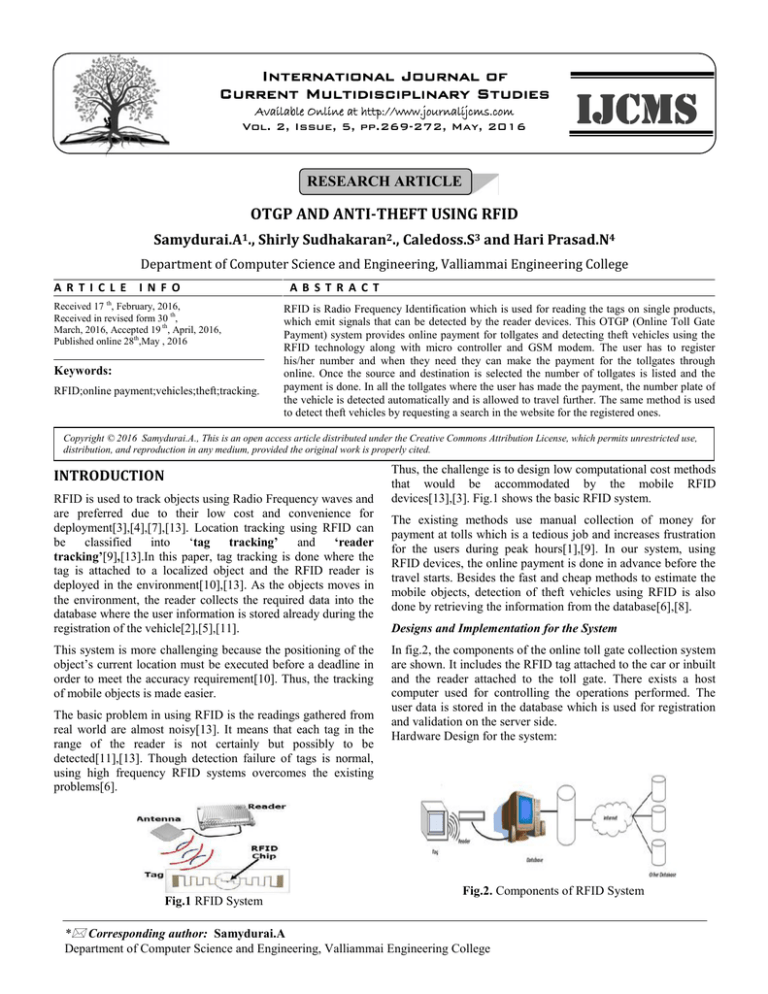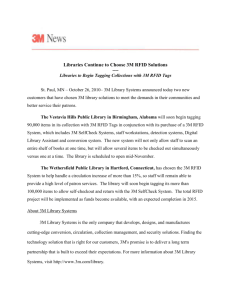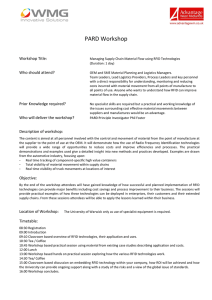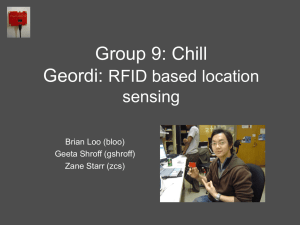
International Journal of
Current Multidisciplinary Studies
Available Online at http://www.journalijcms.com
Vol. 2, Issue, 5, pp.269-272, May, 2016
IJCMS
RESEARCH ARTICLE
OTGP AND ANTI-THEFT USING RFID
Samydurai.A1., Shirly Sudhakaran2., Caledoss.S3 and Hari Prasad.N4
AR TI CL E
Department of Computer Science and Engineering, Valliammai Engineering College
IN F O
Received 17 th, February, 2016,
Received in revised form 30 th,
March, 2016, Accepted 19 th, April, 2016,
Published online 28th,May , 2016
Keywords:
RFID;online payment;vehicles;theft;tracking.
(Closed User Groups)
AB STR A CT
RFID is Radio Frequency Identification which is used for reading the tags on single products,
which emit signals that can be detected by the reader devices. This OTGP (Online Toll Gate
Payment) system provides online payment for tollgates and detecting theft vehicles using the
RFID technology along with micro controller and GSM modem. The user has to register
his/her number and when they need they can make the payment for the tollgates through
online. Once the source and destination is selected the number of tollgates is listed and the
payment is done. In all the tollgates where the user has made the payment, the number plate of
the vehicle is detected automatically and is allowed to travel further. The same method is used
to detect theft vehicles by requesting a search in the website for the registered ones.
Copyright © 2016 Samydurai.A., This is an open access article distributed under the Creative Commons Attribution License, which permits unrestricted use,
distribution, and reproduction in any medium, provided the original work is properly cited.
INTRODUCTION
RFID is used to track objects using Radio Frequency waves and
are preferred due to their low cost and convenience for
deployment[3],[4],[7],[13]. Location tracking using RFID can
be
classified
into
‘tag
tracking’
and
‘reader
tracking’[9],[13].In this paper, tag tracking is done where the
tag is attached to a localized object and the RFID reader is
deployed in the environment[10],[13]. As the objects moves in
the environment, the reader collects the required data into the
database where the user information is stored already during the
registration of the vehicle[2],[5],[11].
This system is more challenging because the positioning of the
object’s current location must be executed before a deadline in
order to meet the accuracy requirement[10]. Thus, the tracking
of mobile objects is made easier.
The basic problem in using RFID is the readings gathered from
real world are almost noisy[13]. It means that each tag in the
range of the reader is not certainly but possibly to be
detected[11],[13]. Though detection failure of tags is normal,
using high frequency RFID systems overcomes the existing
problems[6].
Fig.1 RFID System
Thus, the challenge is to design low computational cost methods
that would be accommodated by the mobile RFID
devices[13],[3]. Fig.1 shows the basic RFID system.
The existing methods use manual collection of money for
payment at tolls which is a tedious job and increases frustration
for the users during peak hours[1],[9]. In our system, using
RFID devices, the online payment is done in advance before the
travel starts. Besides the fast and cheap methods to estimate the
mobile objects, detection of theft vehicles using RFID is also
done by retrieving the information from the database[6],[8].
Designs and Implementation for the System
In fig.2, the components of the online toll gate collection system
are shown. It includes the RFID tag attached to the car or inbuilt
and the reader attached to the toll gate. There exists a host
computer used for controlling the operations performed. The
user data is stored in the database which is used for registration
and validation on the server side.
Hardware Design for the system:
Fig.2. Components of RFID System
* Corresponding author: Samydurai.A
Department of Computer Science and Engineering, Valliammai Engineering College
Samydurai.A, IJCMS, 2016; Vol. 2(5): 269-272.
In the hardware design part the automated system using RFID
technology can be categorized into two modules. They are the
vehicle module and the base module. The vehicle module
consists of the RFID tag and the RFID reader, host computer
system and gate control system composed as the base module.
The general RFID based toll collection system is described in
the fig.3.
Liquid Crystal Display (LCD)
This module is used to display the present status of the system.
Fig.6 is an interface to 4 bit mode with microcontroller LCD
screen consisting of two lines with sixteen characters each.
Fig.6 LCD Display
Fig.3 General RFID based Toll Collection System
The major components used in the hardware design of the
system are:
RFID tag/transponder
As shown in fig.4, an RFID tag/transponder consists of a chip
and an antenna. A chip can store a unique serial number. The
antenna, which is attached to the chip, transmits the data from
the chip to the RFID reader. Typically, a larger antenna
indicates a longer reading range and this range is based on the
type of environment. The tag is attached to the car to be
identified, and can be detected by readers using radio waves.
Fig.4 Internal Structure of RFID Tag
RFID reader
In order for an RFID system to function, it needs a reader that
is capable of reading the tags and communicating the results to
the database. A reader uses its own antenna to communicate
with the tag. The basic tag tracking operation by the RFID
reader is shown in fig.5.
Power Supply Unit
The DC power supply unit is a vital component in modern
electronic equipment as they need a wide range of DC voltages
for their operational purposes. The purpose of power supply is
to provide the required amount of power with the specified
voltage from primary source.
Related Works
There exists a variety of approaches to RFID based tracking and
detection[2],[4],[7],[9],[11]. Most of the toll collection systems
commonly use normal transactions[1]. Some of the related
works use the same RFID technology for toll collections. It uses
a smart card where the transaction is already done and the card
is recharged for future usage[3],[4],[8],[9]. But this system fails
if the user forgets to carry the card or recharge done is not
enough for transactions. Detection of number plate is used but
the system fails if the number plate of the theft vehicle is faked
which has no way to get detected[4]. RFID technology is also
used in student attendance system where the RFID tag of each
student is used to mark attendance for him/her using a RFID
reader [8]. Some of the domestic uses are in the usage of RFID
systems in a Malaysian library replacing the traditional system,
the Walking Plant System (WPC) to watch the growth progress
of plants again replacing the traditional manual method of
watching the plants [8].
OTGP Working Model
The working model of the OTGP system is shown in Fig.7. The
user has to register his/her car number with the required
information. This user data is stored in a database through a host
computer on the client side. The required amount of money is
deducted according to the selected number of toll gates between
the source point and destination point. Then the online payment
is done. When the user passes the toll gate, the RFID tag is
automatically detected by the reader and the vehicle is allowed
for further travel. This is done by retrieving the user stored data
from the database for validation. Thus, a faster sequential
process is performed to avoid traffic jam.
Otgp Process of The System
Fig.5 RFID tracking
Fig.8, clearly shows the step-by-step process of the system. The
RFID reader reads the number from the RFID tag and then it
will check with the recorded database in host computer system.
INTERNATIONAL JOURNAL OF CURRENT MULTIDISCIPLINARY RESEARCH STUDIES
270
Samydurai.A, IJCMS, 2016; Vol. 2(5): 269-272.
If the user did not register, they need to register and the
authorized person at the toll gate gets user information from
them as shown in fig.10. The user can update the balance at the
user updating form.
Fig.10 Number of vehicles through Tollgate
Anti-Theft System
RFID can provide an effective anti-theft system. This is done by
retrieving the data that is already stored by the user during
registration. By doing so the theft vehicle cannot cross the toll
gate and can be tracked using a GSM module.
Fig.7 OTGP Working Model
Otgp Process of The System
Fig.8, clearly shows the step-by-step process of the system.
The RFID reader reads the number from the RFID tag and then
it will check with the recorded database in host computer
system.
If the user did not register, they need to register and the
authorized person at the toll gate gets user information from
them as shown in fig.10. The user can update the balance at the
user updating form.
RESULTS
This report will explain about the utilization of the tollgates
fitted with RFID. This is shown in the below fig.12.
This system provides online payment for tollgates and detecting
theft vehicles using the RFID technology along with microcontroller and GSM modem. The user registers his/her number
and makes the payment for the tollgates through online. In all
the tollgates where the user has made the payment, the number
plate of the vehicle is detected automatically and is allowed to
travel further. The same method is used to detect theft vehicles
by requesting a search in the website for the registered ones.
Thus, RFID enables online payment for toll gates and also plays
a vital role in detecting theft vehicles.
CONCLUSION
Simulation Results
In fig.10 we evaluate the performance of the existing and
proposed systems by considering a more practical scenario
where the vehicle’s time duration in toll plaza varies during
traditional manual collection and automated collection using
RFID. The graph clearly depicts that the time taken during the
automated collection is half the time of the manual collection.
In fig.11, it shows if 10 vehicles can leave the toll plaza in 10
minutes during manual collection then during automated
collection 20 vehicles can leave the toll plaza in the same time.
The following chart gives enhanced information about the
existing and the proposed system.
This report describes that this system is fully automated and
reduces the human error which brings a great evolution in the
method of toll system by its flexibility and it’s fully an
authenticated system. The development of RFID based toll
deduction system is proved that online payments are also
available not only for commercial goods but also in the road
systems. In this toll deduction system RFID is uses permitted
frequency bands by using high power levels for a successful
system. For the future work RFID speed controlled system
vehicle can be save from the accident due to high speed. Some
work must be on RFID communication range between the
reader/antenna and tag is limited into few meters it will be
extend to long range.
Reference
1.
2.
AungMyint Win1, Chaw MyatNwe2, KyawZinLatt3
“RFID Based Automated Toll Plaza System”
International Journal of Scientific and Research
Publications, Volume 4, Issue 6, June 2014 1 ISSN
2250-3153.
Pranoti Salunke1, Poonam Malle2, Kirti Datir3, Jayshree
Dukale4 “Automated Toll Collection System Using
RFID” IOSR Journal of Computer Engineering (IOSR-
INTERNATIONAL JOURNAL OF CURRENT MULTIDISCIPLINARY RESEARCH STUDIES
271
Samydurai.A, IJCMS, 2016; Vol. 2(5): 269-272.
3.
4.
5.
6.
7.
8.
JCE)e-ISSN: 2278-0661, p- ISSN: 2278-8727Volume 9,
Issue 2 (Jan. - Feb. 2013), PP 61-66.
Sachin
Bhosale1,
DnyaneshwarNatha
Wavhal2
“Automated TollPlaza System using RFID” ISSN: 2278
– 7798 International Journal of Science, Engineering
and Technology Research (IJSETR) Volume 2, Issue 1,
January 2013.
RakhiKalantri*1, Anand Parekar#2, Akshay Mohite#3,
Rohan Kankapurkar#4 “RFID Based Toll Collection
System” ISSN:0975-09646 RakhiKalantri et al, /
(IJCSIT) International Journal of Computer Science and
Information Technologies, Vol. 5 (2) , 2014, 2582-2585.
Tejonidhi Aphale1, Rahul Chaudhari2, Jinit Bansod3
“Automated Toll Plaza Using RFID and GSM”
International Journal on Recent and Innovation Trends
in Computing and Communication ISSN: 2321-8169
Volume: 2 Issue: 9 2695 – 2699.
Asif Ali Laghari, M. SullemanMemon and Agha
SherazPathan “RFID Based Toll Deduction System” I.J.
Information Technology and Computer Science, 2012,
4, 40-46 Published Online April 2012 in MECS
(http://www.mecs-press.org/)DOI:
10.5815/ijitcs.2012.04.06.
1Elipe.NageswaraRao,
2G.Tirumala
Vasu,
3N.G.N.Prasad, 4kranthi Kumar, 5V.Rajesh “Payment
Automation at Toll-Gate Using RFID and SMS Alert”
ISSN : 2230-7109(Online) | ISSN : 2230-9543(Print)
IJECT Vol. 2, SP-1, Dec . 2011.
M. Sumithra and B. Buvaneswari “Computerized Toll
Collection System Using Smart Card With Rfid” VOL.
10, NO 21, November, 2015 ISSN 1819-6608 ARPN
Journal of Engineering and Applied Sciences©20062015 Asian Research Publishing Network (ARPN). All
rights reserved.
9.
10.
11.
12.
13.
Priyanka .V1, Punitha .S .P2, Keerthika .K3 1,
“Automation of Tollgate and Vehicle Tracking System”
International Journal of Science and Research (IJSR)
ISSN (Online): 2319-7064 Index Copernicus Value
(2013): 6.14 | Impact Factor (2013): 4.438.
Weiping Zhu, StudentMember, IEEE, Jiannong Cao,
Senior Member, IEEE, Henry C. B. Chan, Member,
IEEE, Xuefeng Liu, Member, IEEE, and Vaskar
Raychoudhury, Member, IEEE “Mobile RFID with a
High Identification Rate” IEEE Transactions on
Computers, VOL. 63, NO. 7, JULY 2014.
Chung-Hao Huang, Lun-Hui Lee, Chian C. Ho, LangLong Wu, and Zu-Hao Lai “Real-Time RFID Indoor
Positioning System Based on Kalman-Filter Drift
Removal
and
Heron-Bilateration
Location
Estimation”IEEE Transactions on Instrumentation And
Measurement, VOL. 64, NO. 3, MARCH 2015.
Po Yang “PRLS-INVES: A General Experimental
Investigation Strategy for High Accuracy and Precision
in Passive RFID Location Systems” IEEE Internet OF
Things Journal, VOL. 2, NO. 2, APRIL 2015.
Lei Yang, Jiannong Cao, Senior Member, IEEE, Weiping
Zhu, Member, IEEE, and Shaojie Tang, Member, IEEE
“Accurate and Efficient Object Tracking “Based on
Passive Rfid” IEEE Transactions On mobile computing,
Vol. 14, No. 11, November 2015.
*******
INTERNATIONAL JOURNAL OF CURRENT MULTIDISCIPLINARY RESEARCH STUDIES
272



